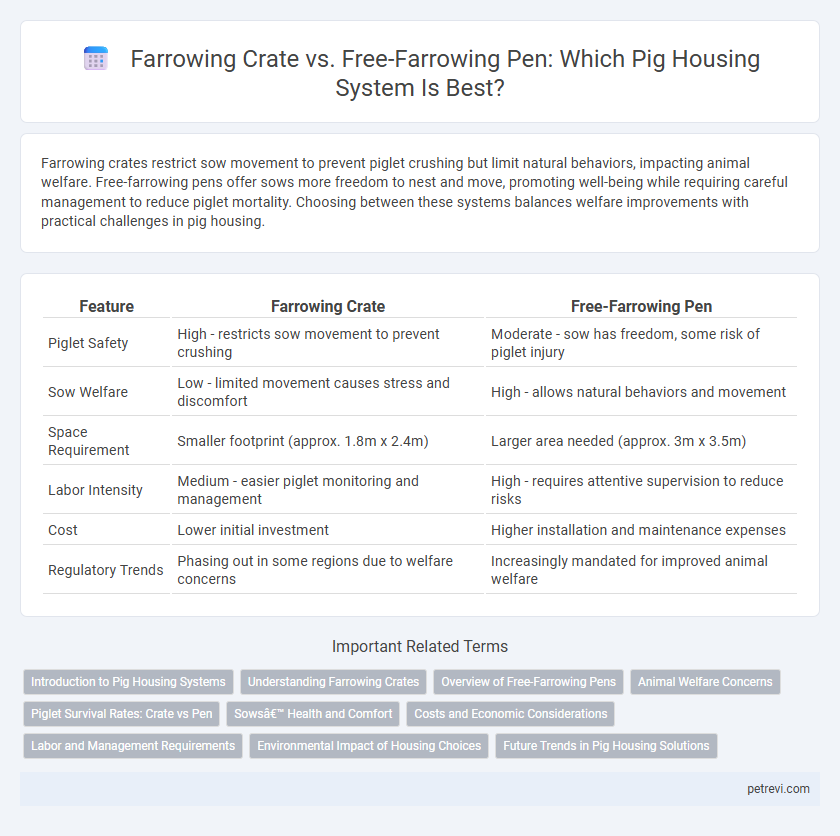Farrowing crates restrict sow movement to prevent piglet crushing but limit natural behaviors, impacting animal welfare. Free-farrowing pens offer sows more freedom to nest and move, promoting well-being while requiring careful management to reduce piglet mortality. Choosing between these systems balances welfare improvements with practical challenges in pig housing.
Table of Comparison
| Feature | Farrowing Crate | Free-Farrowing Pen |
|---|---|---|
| Piglet Safety | High - restricts sow movement to prevent crushing | Moderate - sow has freedom, some risk of piglet injury |
| Sow Welfare | Low - limited movement causes stress and discomfort | High - allows natural behaviors and movement |
| Space Requirement | Smaller footprint (approx. 1.8m x 2.4m) | Larger area needed (approx. 3m x 3.5m) |
| Labor Intensity | Medium - easier piglet monitoring and management | High - requires attentive supervision to reduce risks |
| Cost | Lower initial investment | Higher installation and maintenance expenses |
| Regulatory Trends | Phasing out in some regions due to welfare concerns | Increasingly mandated for improved animal welfare |
Introduction to Pig Housing Systems
Farrowing crates are designed to restrict sow movement, minimizing piglet crushing and facilitating easier management during farrowing, but raise welfare concerns due to limited sow mobility. Free-farrowing pens provide sows with more freedom to move, promoting natural behaviors and potentially improving sow welfare, though they may require enhanced management to reduce piglet mortality. Considering pig housing systems, the balance between piglet survival rates and sow welfare is critical in selecting farrowing accommodation.
Understanding Farrowing Crates
Farrowing crates are designed to confine sows during farrowing to minimize piglet crushing and improve piglet survival rates, providing restricted movement while allowing piglets to nurse safely. This housing system prioritizes sow and piglet protection but raises concerns regarding animal welfare due to limited sow mobility and natural behaviors. Understanding the balance between piglet safety and sow welfare is essential for optimizing housing strategies in commercial pig production.
Overview of Free-Farrowing Pens
Free-farrowing pens provide sows with increased freedom of movement during farrowing, reducing stress and promoting natural maternal behaviors compared to restrictive farrowing crates. These pens enhance piglet survival by allowing sows to adjust their position, minimizing crushing risks while maintaining sufficient protection for newborns. Welfare improvements in free-farrowing systems align with modern livestock production standards emphasizing ethical treatment and sustainable farming practices.
Animal Welfare Concerns
Farrowing crates restrict sow movement, leading to increased stress and stereotypic behaviors, while free-farrowing pens allow natural nest-building and social behaviors that improve sow welfare. Studies show that piglets in free-farrowing systems experience lower mortality rates due to reduced crushing incidents and better maternal interaction. Animal welfare organizations advocate for transitioning to free-farrowing pens to enhance physical and psychological well-being of sows.
Piglet Survival Rates: Crate vs Pen
Farrowing crates restrict sow movement but significantly reduce piglet crushing, leading to higher piglet survival rates compared to free-farrowing pens. Free-farrowing pens offer increased sow comfort and natural behaviors but often result in elevated piglet mortality due to accidental crushing. Studies indicate survival rates can be up to 10-15% higher in farrowing crates versus free-farrowing systems, emphasizing the trade-off between welfare and piglet safety.
Sows’ Health and Comfort
Farrowing crates restrict sows' movement, leading to increased stress and higher risk of shoulder sores and lameness, negatively impacting overall health and welfare. Free-farrowing pens offer greater freedom of movement, which promotes natural behaviors, reduces stress, and improves musculoskeletal condition and comfort for sows. Studies show improved sow longevity and piglet survival rates in free-farrowing systems, highlighting the benefits of enhanced health and comfort.
Costs and Economic Considerations
Farrowing crates typically involve lower initial construction costs compared to free-farrowing pens due to simpler design and reduced space requirements, but they may result in higher labor expenses linked to piglet management and injury prevention. Free-farrowing pens demand greater capital investment, including larger space allocation and advanced monitoring systems, yet they can enhance sow welfare and reduce piglet mortality, potentially leading to improved growth rates and market returns. Economic considerations must balance upfront infrastructure costs against long-term productivity gains and welfare-driven market premiums associated with free-farrowing systems.
Labor and Management Requirements
Farrowing crates demand intensive labor for regular sow monitoring and piglet management due to restricted movement, which simplifies tasks like feeding and cleaning but requires constant vigilance to prevent piglet crushing. Free-farrowing pens reduce the need for continuous sow restraint, allowing more natural behaviors, yet they increase labor complexity as caregivers must provide enhanced supervision and intervention to ensure piglet safety. Effective management in both systems hinges on balancing labor input with piglet welfare, with free-farrowing pens necessitating more skilled and attentive staff to maintain optimal outcomes.
Environmental Impact of Housing Choices
Farrowing crates restrict sow movement, leading to concentrated waste and increased ammonia emissions, which negatively impact air quality and contribute to greenhouse gas effects. Free-farrowing pens allow for better waste dispersion and improved manure management, reducing environmental pollutants and soil contamination. Optimizing pig housing toward free-farrowing systems supports sustainable farming by minimizing nitrogen runoff and enhancing overall ecosystem health.
Future Trends in Pig Housing Solutions
Future trends in pig housing emphasize animal welfare improvements, with free-farrowing pens gaining traction as alternatives to farrowing crates due to enhanced sow freedom and piglet safety. Innovations incorporate automated monitoring systems and enriched environments, promoting natural behaviors while maintaining productivity. Sustainable design and precision livestock farming technologies are driving a shift towards more ethical and efficient farrowing solutions globally.
Farrowing crate vs Free-farrowing pen for Pig housing Infographic

 petrevi.com
petrevi.com